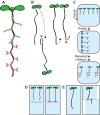To branch or not to branch: the role of pre-patterning in lateral root formation
- PMID: 24130327
- PMCID: PMC4007709
- DOI: 10.1242/dev.090548
To branch or not to branch: the role of pre-patterning in lateral root formation
Abstract
The establishment of a pre-pattern or competence to form new organs is a key feature of the postembryonic plasticity of plant development, and the elaboration of such pre-patterns leads to remarkable heterogeneity in plant form. In root systems, many of the differences in architecture can be directly attributed to the outgrowth of lateral roots. In recent years, efforts have focused on understanding how the pattern of lateral roots is established. Here, we review recent findings that point to a periodic mechanism for establishing this pattern, as well as roles for plant hormones, particularly auxin, in the earliest steps leading up to lateral root primordium development. In addition, we compare the development of lateral root primordia with in vitro plant regeneration and discuss possible common molecular mechanisms.
Keywords: Auxin; Callus formation; Lateral root development; Periodic gene expression; Pre-patterning.
Figures



Similar articles
-
Stepwise understanding of root development.Curr Opin Plant Biol. 2005 Feb;8(1):71-6. doi: 10.1016/j.pbi.2004.11.014. Curr Opin Plant Biol. 2005. PMID: 15653403 Review.
-
Regulation of Hormonal Control, Cell Reprogramming, and Patterning during De Novo Root Organogenesis.Plant Physiol. 2018 Feb;176(2):1709-1727. doi: 10.1104/pp.17.00980. Epub 2017 Dec 12. Plant Physiol. 2018. PMID: 29233938 Free PMC article.
-
Root system patterning: auxin synthesis at the root periphery.Curr Biol. 2015 Jun 1;25(11):R460-2. doi: 10.1016/j.cub.2015.04.013. Curr Biol. 2015. PMID: 26035789
-
Lateral root initiation requires the sequential induction of transcription factors LBD16 and PUCHI in Arabidopsis thaliana.New Phytol. 2019 Oct;224(2):749-760. doi: 10.1111/nph.16065. Epub 2019 Aug 10. New Phytol. 2019. PMID: 31310684
-
Zygotic Embryogenesis in Flowering Plants.Methods Mol Biol. 2021;2288:73-88. doi: 10.1007/978-1-0716-1335-1_4. Methods Mol Biol. 2021. PMID: 34270005 Review.
Cited by
-
Natural variation and domestication selection of ZmSULTR3;4 is associated with maize lateral root length in response to salt stress.Front Plant Sci. 2022 Oct 26;13:992799. doi: 10.3389/fpls.2022.992799. eCollection 2022. Front Plant Sci. 2022. PMID: 36388478 Free PMC article.
-
Growing Out of Stress: The Role of Cell- and Organ-Scale Growth Control in Plant Water-Stress Responses.Plant Cell. 2016 Aug;28(8):1769-82. doi: 10.1105/tpc.16.00182. Epub 2016 Aug 8. Plant Cell. 2016. PMID: 27503468 Free PMC article. Review.
-
OsFPFL4 is Involved in the Root and Flower Development by Affecting Auxin Levels and ROS Accumulation in Rice (Oryza sativa).Rice (N Y). 2020 Jan 7;13(1):2. doi: 10.1186/s12284-019-0364-0. Rice (N Y). 2020. PMID: 31912314 Free PMC article.
-
Nitrate foraging by Arabidopsis roots is mediated by the transcription factor TCP20 through the systemic signaling pathway.Proc Natl Acad Sci U S A. 2014 Oct 21;111(42):15267-72. doi: 10.1073/pnas.1411375111. Epub 2014 Oct 6. Proc Natl Acad Sci U S A. 2014. PMID: 25288754 Free PMC article.
-
AtMYB93 is an endodermis-specific transcriptional regulator of lateral root development in arabidopsis.Plant Signal Behav. 2014;9(10):e970406. doi: 10.4161/15592316.2014.970406. Plant Signal Behav. 2014. PMID: 25482809 Free PMC article.
References
-
- Atta R., Laurens L., Boucheron-Dubuisson E., Guivarc’h A., Carnero E., Giraudat-Pautot V., Rech P., Chriqui D. (2009). Pluripotency of Arabidopsis xylem pericycle underlies shoot regeneration from root and hypocotyl explants grown in vitro. Plant J. 57, 626–644 - PubMed
-
- Bell J. K., McCully M. E. (1970). A histological study of lateral root initiation and development in Zea mays. Protoplasma 70, 179–205
-
- Benková E., Michniewicz M., Sauer M., Teichmann T., Seifertová D., Jürgens G., Friml J. (2003). Local, efflux-dependent auxin gradients as a common module for plant organ formation. Cell 115, 591–602 - PubMed
-
- Beveridge C. A., Mathesius U., Rose R. J., Gresshoff P. M. (2007). Common regulatory themes in meristem development and whole-plant homeostasis. Curr. Opin. Plant Biol. 10, 44–51 - PubMed
Publication types
MeSH terms
Substances
LinkOut - more resources
Full Text Sources
Other Literature Sources

